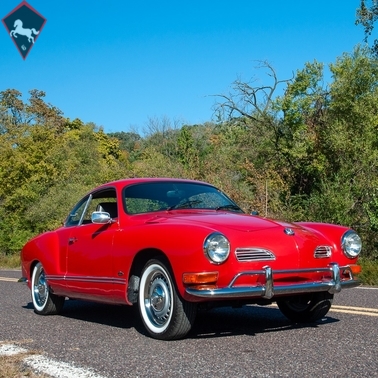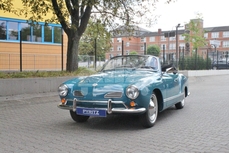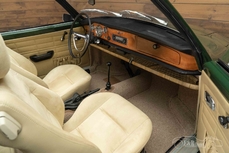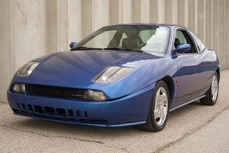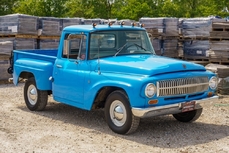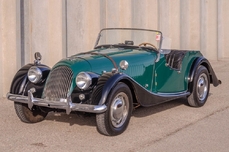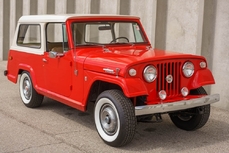Volkswagen Karmann-Ghia 1.6L flat four-cylinder 1971
General description :
1971 Volkswagen Karmann Ghia
Same previous owner for 37 years!
Was stored in a private Florida collection for many years
Very original vehicle throughout
Original USA-only Dual Port 1.6L air-cooled flat four-cylinder engine #AE334948
Four-speed manual transmission
Red exterior with a black interior
Front disc brakes
15-inch painted steel wheels with vented center caps, beauty rings
Bucket seats, fold-down rear seat
Documentation includes the original owner’s manual plus
Own this Vehicle from $299 per month-call 636-600-4600
If you’ve scoured for a classic Volkswagen to buy that is not a Beetle, come on down to MotoeXotica Classic Cars to check out this 1971 Volkswagen Karmann Ghia. It was a sports car marketed in 2+2 coupe (1955–1974) and convertible (1957–1974) body styles. The Karmann Ghia combined the chassis and mechanicals of the Type 1 (Beetle) with styling by Italy’s Carrozzeria Ghia and hand-built bodywork by German coachbuilding house, Karmann.
This Ghia comes from a previous owner of 37 years! Copy of the 1981 Florida title and original manual is included.
Finished in Red, this mostly original example was built in December 1970 in Osnabruck, West Germany. The car’s paint and trim are in overall excellent condition. The car’s glass panels are clear and intact and includes a rear defroster and swing-out rear quarter windows, while the lights are haze-free and look good.
The car’s bodywork is straight, the engine bay is extremely tidy and the battery appears new. The chrome, bladed bumpers shine brilliantly and this car rides on Atlas whitewall tires. Each tire is mounted on 15-inch painted steel wheels with vented center caps and beauty rings.
Out back is the original USA-only market dual port 1.6L air-cooled flat four-cylinder engine #AE334948 producing 60HP, flat four-cylinder engine linked to a four-speed manual transmission. Driver convenience features include front disc brakes.
Inside, the car’s black interior is in overall great shape. The black front buckets and fold-down rear seats are in excellent condition while the complementing carpet is in satisfactory shape. The contrasting grayish headliner looks great, as does the factory, two-spoke steering wheel but the horn is inoperable. The black instrument panel with VDO gauges is in very good order while the inner door panels are in satisfactory shape. Rounding out the interior are the floor-mounted shifter and a Kenwood AM/FM stereo with CD player.
The design and prototype were well received by Volkswagen executives, and the Type 14 debuted at the October 1953 Paris Auto Show as a styling concept “by Ghia.” In August 1955 the first Type 14 was manufactured in Osnabrück, Germany. Public reaction to the Type 14 exceeded expectations, and more than 10,000 were sold in the first year.
In contrast to the Beetle’s machine-welded body with bolt-on fenders, the Karmann Ghia’s body panels were butt-welded, hand-shaped, and smoothed with English pewter in a time-consuming process commensurate with higher-end manufacturers, resulting in the Karmann Ghia’s higher price.
The Type 14 was marketed as a practical and stylish 2+2 rather than as a true sports car. As they shared engines, the Type 14’s engine displacement grew concurrently with the Type 1 (Beetle), ultimately arriving at a displacement of 1584 cc.
Production doubled soon after the Karmann Ghia’s introduction, becoming the car most imported into the U.S.
In August 1957, Volkswagen introduced a convertible version of the Karmann Ghia. Exterior changes in 1961 included wider and finned front grilles, taller and more rounded rear taillights and headlights relocated to a higher position – with previous models and their lower headlight placement called lowlights. The Italian designer Sergio Sartorelli, designer of Type 34, oversaw the various re-stylings of Type 14.
In 1970, larger taillights integrated the reversing lights and larger wrap-around turn signals. Still larger and wider taillights increased side visibility.
Competition to this Ghia in 1971 include Buick’s captively imported Opel GT Coupe, Chevrolet’s Vega hatchback, Dodge’s Colt coupe, Ford’s Pinto hatchback, Honda’s Civic hatchback, Mazda’s 1000, Mercury’s Bobcat hatchback, Pontiac’s Astre hatchback and Toyota’s Corolla Coupe.
Documentation includes the original owner’s manual plus various maintenance receipts and other documents. Stop by MotoeXotica Classic Cars today to check out this classic VW coupe before someone else puts in their garage.
VIN: 1412622639
This car is currently located at our facility in St. Louis, Missouri. Current mileage on the odometer shows 27,141 miles. It is sold as is, where is, on a clean and clear, mileage exempt title. GET OUT AND DRIVE!!!
Please Click Here to View Our YouTube Video!!!
Copy & Paste the Link Below to View Our YouTube Video:
https://youtu.be/tZE3lpindhw
https://www.motoexotica.com/inventory/listing/1971-volkswagen-karmann-ghia-4/
1971 Volkswagen Karmann-Ghia 1.6L flat four-cylinder is listed sold on ClassicDigest in Fenton (St. Louis) by for $19900.
Car Facts
Car type : Car Make : Volkswagen Model : Karmann-Ghia Model Version : 1.6L flat four-cylinder Engine size : 1.6 Model Year : 1971 Sub type : Coupé Location : Fenton (St. Louis)
Sold
Seller Information
Sold
People who viewed this Volkswagen Karmann-Ghia also viewed similar Volkswagen listed at ClassicDigest
Other cars listed for sale by this dealer
About Volkswagen
The Volkswagen story is indeed an intriguing tale of innovation, resilience, and post-war revival, marked by various models that have become iconic in automotive history.The People's Car (Volkswagen): Initially envisioned by Adolf Hitler in the 1930s as a "people's car" or "Volkswagen" in German, the idea was to create an affordable and practical vehicle for the German people. This concept led to the development of the Volkswagen Beetle (or the Type 1), designed by Ferdinand Porsche.
Post-War Challenges: After World War II, Volkswagen faced significant challenges. The factory was heavily damaged, and the brand's association with the Nazi regime led to a lack of interest in the car in some regions.
British Intervention - The British Army & Ivan Hirst: The British Army took control of the factory in the immediate post-war period. Major Ivan Hirst, a British Army officer, played a crucial role in reviving Volkswagen. He recognized the potential of the Beetle and advocated for its production, convincing the British military to order several thousand cars. This decision helped jumpstart the brand's revival.
Export Success and the Beetle's Global Appeal: The Beetle gained popularity not only in Germany but also globally, becoming an icon of affordable motoring. Its simple, reliable design and unique appearance made it a favorite among consumers worldwide.
Model Evolution: Over the years, Volkswagen introduced various models alongside the Beetle, each contributing to the brand's growth:
Type 2 (VW Bus or Transporter): Introduced in the 1950s, it became an iconic symbol of the hippie movement in the 1960s, loved for its spaciousness and versatility.
Golf (Rabbit in the U.S.): Launched in the mid-1970s, the Golf (or Rabbit in the U.S.) marked a shift towards front-wheel-drive, modern design, and hatchback practicality, becoming a cornerstone of the brand's success.
Passat, Jetta, and Other Models: Volkswagen expanded its lineup with models like the Passat and Jetta, catering to different market segments.
Challenges and Innovations: Despite success, Volkswagen faced challenges, including quality issues in the 1970s. However, the brand continued to innovate and develop new models and technologies.
Rise of the GTI and Global Expansion: The 1980s saw the rise of the iconic Golf GTI, a high-performance version that sparked the hot hatch trend. Volkswagen also expanded its global presence during this period.
The British intervention in reviving Volkswagen after World War II played a pivotal role in the brand's resurgence. While there might have been some tensions or competition among automotive companies in the 1950s and 1960s due to Volkswagen's post-war success, the brand's ability to produce innovative and popular models solidified its place in automotive history.
